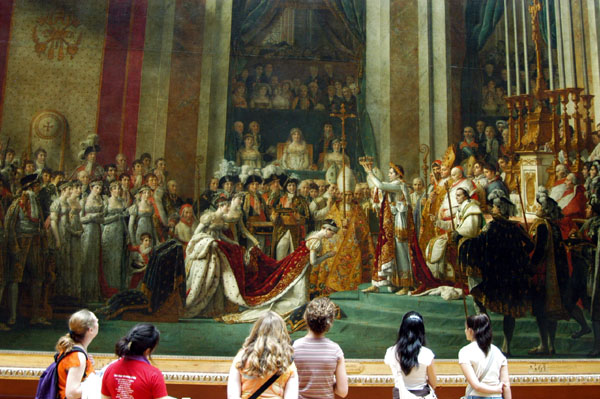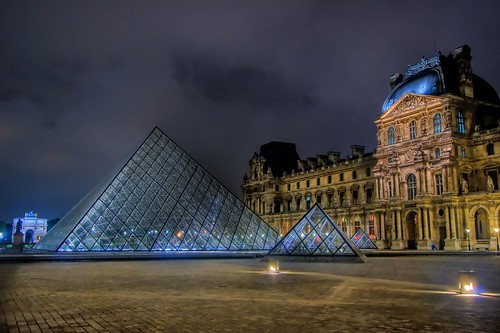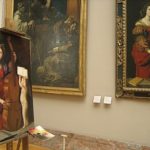One of the major highlights of My Tour de France was our fast and furious 5 hours at the beautiful Musee du Louvre in Paris, aka the Louvre Museum.
With 652,300 square feet of exhibition space, 5 floors and 17 wings, the Grand Louvre is one of the most famous museums in the world. In 2008, more than 8.5 million visitors flocked to this number one ranked museum.
The Louvre contains over 380,000 objects and displays 35,000 works of art. It is said that if one was to walk through the Louvre and spend only 4 seconds gazing at each object, it would take you three months to get through the whole museum!
That said, I have one bit of advice…arrive early, wear comfortable shoes and don’t forget to grab a map! Even with the map in hand, my daughter and I had a difficult time navigating through the many corridors, rooms and throng of people.
The Mona Lisa is most visited piece of art in the museum, so we decided to meet her first. That must have been the plan of the day for all museum goers. So, like a herd of cattle we made our way to the Denon Wing on the southern side of the Louvre.
On our way we stopped to see Winged Victory, one of the most celebrated sculptures in the world. The compelling marble sculpture dated 220-190 BC, is prominently displayed and is quite breathtaking. I am amazed how the sculptor carved out of stone, the sensation of rippling garments in a strong sea breeze.
 (Winged Victory)
(Winged Victory)
We stopped to see many famous and historical paintings on our way to Leonardo de Vinci’s masterpiece, the Mona Lisa. It was fun to see many artists had their easels set up and were painting in this area of the museum.
(artists copying the old masters)
After being pushed, shoved and elbowed, my daughter and I finally made it to the Mona Lisa. Surprisingly, this was the off-season…I can’t imagine what the middle of summer would be like. We gave up trying to get a closer look at Mona and enjoyed watching the people. In fact, ‘people watching’ became almost as interesting as viewing the art!
Mona Lisa seems to welcome you in silent communication with her fixed gaze on the observer. Her brightly lit face is softly framed by darker elements using the sfumato painting technique which evokes a mysterious and haunting effect.
The celebrated painting has survived for over 500 years, but was relatively unknown until the mid 19th century. Since then, the 30” x 20 7/8” Mona Lisa has endured being stolen, doused with acid and later damaged by a rock that was thrown at her. The Mona Lisa is literally considered to be priceless. She is not even insured! No wonder she now smiles serenely at us from behind 4 centimeters of a bulletproof glass, climate controlled enclosure.
(crowds swarm the Mona Lisa from a safe distance)
We left the busy Italian section of the Louvre and meandered throughout the major halls of the vast museum. Although it was not as crowded, we got lost from time to time and had to ask for directions. We enjoyed seeing the many famous paintings that we learned about in art history.

(tourists are dwarfed by the many enormous paintings in the Louvre)
There are so many treasures in the Louvre that it boggles the mind. Besides the many ancient artifacts and awe inspiring sculptures we saw Monet, Van Gogh, Vermeer, Corot, Raphael, Rembrant, Titan, Valazques, Waterhouse, Whistler and more. One truly could spend months wandering around in the Louvre!
Lori 🙂
PS. Here’s a brief history lesson…
-
The Louvre has dominated central Paris since the late 12th century and has undergone many architectural metamorphoses.
-
The Louvre was originally built as a fortress to defend Paris against Viking attacks.
-
In the 14th century, Charles V turned it into a palace for the arts, but Francois I and Henri II tore it down and built a splendid royal palace.
-
The next 300 years, the palace went through many transformations until its completion in the early 1600’s under Louis XIV.
-
Following the completion of Versailles, the royals lost interest in the Louvre.
-
1793 the Museum Central des Arts opened to the public in the Grande Galerie.
-
1882 the art museum began to take over the majority of the complex which marked the birth of the modern Louvre.













The thing that really amazed me about the Mona Lisa was that she was so small. All of the poster-sized reproductions had prepared me for a larger scale, and then she was child-sized. I was not sure what I was expecting, but when I looked at the painting I suddenly wanted to look after it, which was not at all what I had been thinking. A little while later I was the huge picture of Cardinal Richelieu, which was my other favourite thing of the day, and together the two bracketed the sizes I could fit into my head in a limited time.
Hi Diana,
I am slow to catching up on comments lately…thanks for your patience. The first time I saw ‘Mona’ I thought the same thing! She is small, and I loved seeing her in person. It was so crowded though!
Thanks for the visit-
Lori
Lori,
Upon a visit to The Louvre last week, my daughter and I saw a painting of 5-6 women at sea, rowing furiously through a storm. There appeared to be a land mass in the distance which they were rowing towards.
Amost as if they had been shipwrecked.
Would you happen to know the artist andor title of that painting?
Thanks
Hello Kurt,
You are lucky!! I want to go back someday soon…I could spend a week there. I do not know who the artist is offhand. If I can figure it out, I will let you know. Thanks for sharing.
Lori
Thank you for the tips on visiting the Louvre. I’m in the midst of planning a visit in two weeks and need all the help I can get to pack in as much as possible in the limited time I have! A day does not seem enough to me.
Hello Celia,
I wish I would have had more time to spend at that amazing museum. I could spend a week in there…easily!!! My other suggestion would be to get a map and find your top priorities to target. Then you will see the important highlights first and can enjoy the rest of your visit wandering through. Have a great trip!
Cheers-
Lori
MUY BUENOS SUS ARTÌCULOS CUYA PROFUNDIDAD CONCEPTUAL REVELA UN PROFUNDO CONOCIMIENTO
DE LA TEMÀTICA HUMANA,TANTO COMO LA DEL CAMPO ARTÌSTICO.FELICITACIONES Y ADELANTE.
CARLOS DIGNANI
Hola Carlos, Lo que un buen cumplido. Gracias por visitar este sitio y me alegro mucho de estos puestos son útiles e informativos para usted.
Muchas gracias,
Lori